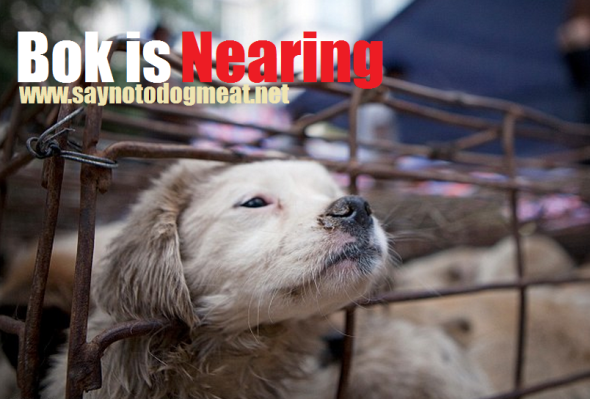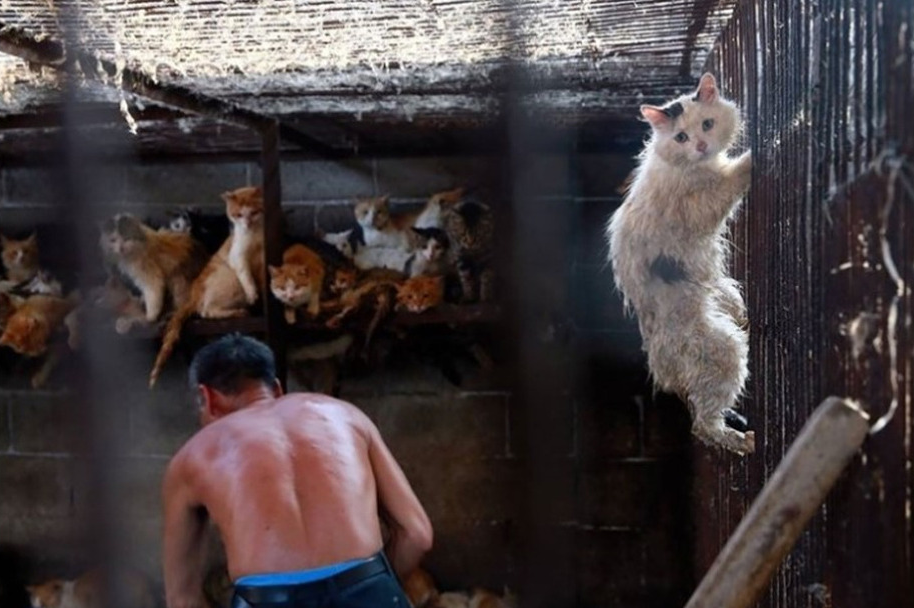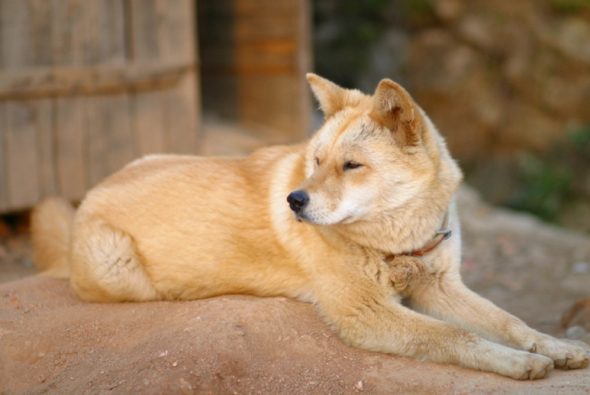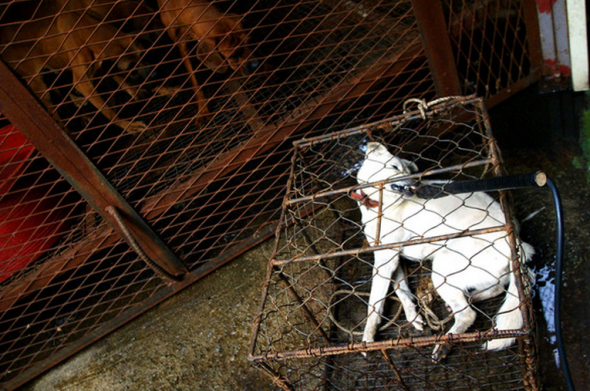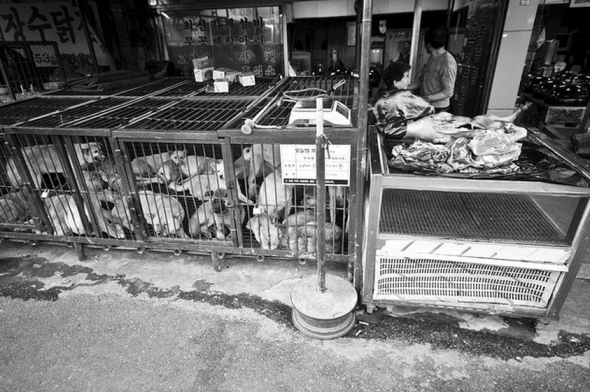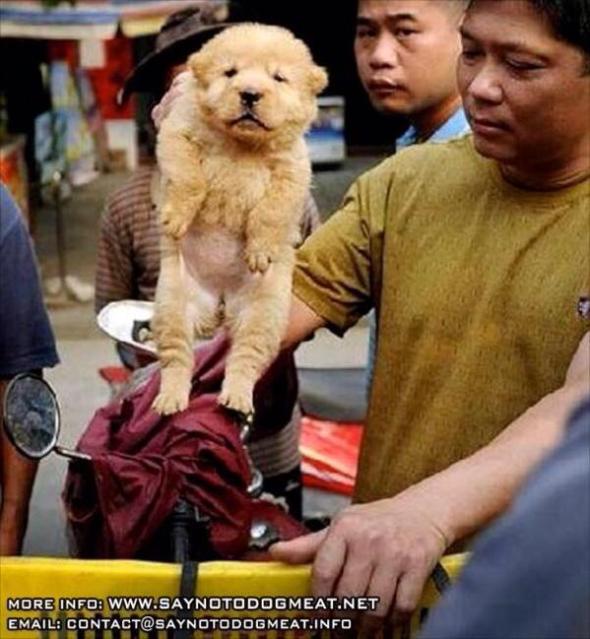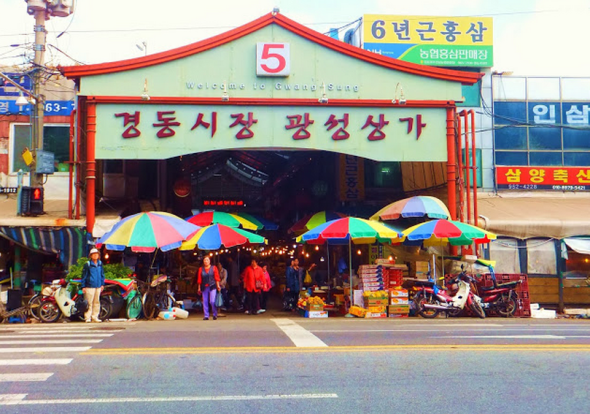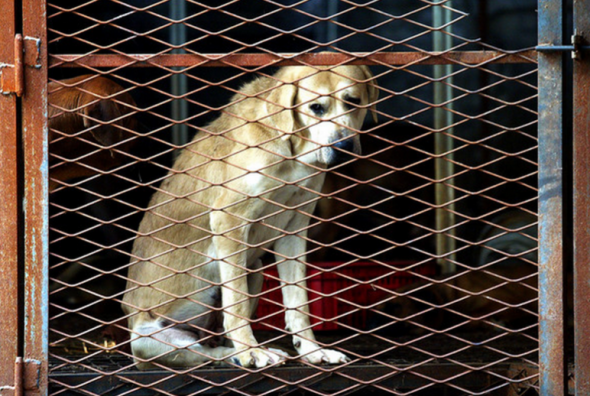Bok Nal: Dog Eating Days - South Korea.
July - August Malbok Festival
South Korea which is located in the southern half of the Korean Peninsular of east Asia will this July to early August host its annual dog meat-eating festival commonly known as “Bok Day”, “Bok Days” or the Malbok Festival. The festival normally begins on the 13th July or 21st July, and runs into early August which is considered the hottest days of the year within the country.
General description:
The event is hosted on the first “Cho Bok” first summer continuing through to “Joong Bok”, mid-summer, on the 28th, and “Mal Bok”, end of summer, on August 7th, lasting 21 days. It’s during this event that South Korean dog and cat meat markets will begin a mass slaughter of dogs and cats. One particularly commonly killed dog is the “Noo-rung-yee” or commonly known as the “Nureongi” a yellowish traditional dog breed that has been bred to specifications over time within East Asia. There are various terms used for this festival which I’ve included within the entire article for your information and research.
To date, and like the Yulin festival there remains no factual estimates from governmental research or observation counts to place an exact number to how many dogs or cats are killed during the twenty-one day event. Some critics have placed the number of “dogs” killed during the entire “Bok Day - dog meat-eating days” at some one million dogs killed during this cruel and barbaric festival. Meanwhile other organisations and critics have placed the number at a much reduced count at some 15,000 during the Malbok Festival.
Sambok (삼복), also known as Boknal (복날), or the dog days of summer, covers a month of time at the peak of the growing season and traditional time that to some South Koreans is classified as a traditional time to cool off and extract some medicinal healing powers from the consumption of dog meat. In reality there still remains no proof or medical evidence that supports the East Asian pet meat consuming beliefs that such meats increase human health.
Image: No mercy for cats either at the Malbok Festival.
The most commonly consumed dish during the South Korean Malbok festival is that of peppery dog meat soup (quite a commonly consumed dish that we have noted within western Africa and central Africa). During the festival dogs will be seen roasted and served on a spit, and prepared in stews too. However as explained the most commonly sought after dish is that of peppery dog meat soup known as (bosintang or gaejang-guk) a dish that is steeped in history dating back thousands of years, and is now commonly consumed throughout western, central and northern Africa.
International Animal Rescue Foundation Africa has uncovered in the years of intensive bush and pet meat trade research Asian construction workers bringing the dish and recipes into the African continent. The environmental companies most shocking report that has yet to be released will finally prove that south Africa has more than its fair share of dog meat traders with illegal “404” joints too.
Bosintang aka gaejang-guk:
Bosintang or “dog meat cuisine” as the dish is commonly known remains part of the traditional south Korean dish. Research on the north Korean pet meat trade also indicates bosintang to be a commonly consumed soup eaten throughout the year. furthermore within the “404 restaurants of Lagos, Abuja and Jos in Nigeria the exact same dish is consumed by locals commonly with very potent gin”.
In reports last month and last year I.A.R.F.A and Say No To Dog Meat have unearthed very concerning data regarding dog meat and gin trade of which has seen countless scores of people dropping dead like flies. International Animal Rescue Foundation Africa and Say No To Dog Meat also uncovered hard and firm evidence that migrant workers from south Korea, China and Viet Nam had introduced the dish of gaejang-guk into the plateau states.
The main primary ingredient of Bosintang or - Gaejangguk (개장국, -醬-) - as its more commonly known in south Korea is dog meat. Dog meat is boiled with a range of aromatic and fresh vegetables with herbs such as chamomile and dandelion added to the dish. (Its believed by some tourists and locals the inclusion of these scented herbs is to remove the strong pungent, and at times nauseating aroma of stewed dog. Doenjang (된장), Gochujang (고추장), and perilla seed powder are also known to be included within this rather unsavory dish.
Bosintang has quite an extensive history within south Korean traditional food. Dating as far back to the 4th century ((AD) After the Death of Christ). We know this because of evidence that was located on the wall painting in the Goguryeo tombs complex in South Hwanghae Province, a UNESCO World Heritage site which dates from 4th century AD, depicts a slaughtered dog in a storehouse (Ahn, 2000). (Please refer to the UNESCO World Heritage site for further information).
The Balhae people also enjoyed dog meat, and the Koreans’ appetite for canine cuisine seems to have come from that era. So in all fairness it’s quite possible the Malbok festival or a similar festival will also be hosted within north Korea too. If this is true then the vast number of dogs killed and consumed for meat will heavily exceed all kill and consume estimates from organisations and animal rights individuals. Unfortunately as we’re unable to freely travel into north Korea to document on this case we’ll never know the full truth. Please do stay tuned though.
During the first day of the Malbok festival (BOK - the first day that consumers are encouraged to dine on the traditional soup or stews), other types of dishes will be on the menu - something that the Australian organisation (Say No To Dog Meat.Net) are currently demanding to be removed off the menu within south Korea.
Image: “Nureongi” a traditional dog breed commonly killed for meat within Asia.
These dishes include:
- Bosintang (보신탕; 補身湯); Gaejangguk (개장국)) – Stew containing boiled dog meat and vegetables.
- Gaegogi Jeongol (개고기 전골) – An elaborate dog stew made in a large Jeongol pan.
- Gae Suyuk (개 수육; 개水肉)- Boiled dog meat
- Gaegogi Muchim (개고기 무침) – Steamed dog meat, Korean leeks (부추), and vegetables mixed with spices
- Gaesoju (개소주; 개燒酒) – Mixed drink containing dog meat and other Chinese medicine ingredients such as ginger, chestnut, and jujube to invigorate one’s health.
~ Source Wiki
While all dishes are considered grotesque, probably the most vile and repulsive of them all is that of the Gaesoju (개소주; 개燒酒). When I say vile I truly mean “vile and utterly bloody disgusting”. There remains some mystery as to what is included within this trinket of liquid dog meat although the very basic ingredients are known. Research from universities in Maine and California have located liquefied dog meat being the primary ingredient, intestines (not normally used in this liqueur type drink), traces of dog hair, teeth, herbs, spices, blood, beef and an entire textbook of virus’s, diseases and, toxins that would normally harm the non-pet-meat consumer.
Both Maine and California scientists confirmed that no medicinal properties were located in either samples or synthetic medications that could give the illusion such a tonic increases libido, lowers blood pressure, wards of evil spirits, prevents miscarriages and, acts as a bodily coolant. However as the tonic, stew and soup are consumed with “liquid” the liquid itself I.e common water helps by decreasing dehydration which in turn helps to cool the body down.
Has the common old aged belief which states “soup” can help decrease dehydration, and helps to reduce cold like symptoms been taken a little to far within in traditional Asian food and medicine culture? It’s possible and what’s more as soup contains liquid I.e water it does indeed help cool the body and relieve some cold like symptoms which is a proven scientific fact.
Cuisine Row and Moran Market:
Cuisine Row - commonly referred to by international tourists as the “Postcard Row” is located behind the local Seoul City Hall which is an area where many dog meat restaurants trade during the Malbok festival. It’s wrong for anyone to state that the festival is confined just to Moran Meat Market as the festival is a common country event gathering that thousands of people attend during the first Cho Bok (first summer) of the Malbok festival.
Back in 2014 one of Seoul’s most “infamous” yet liked restaurants within the “Cuisine Row” closed its doors to trade. Daegyo, an acclaimed Seoul restaurant that had been serving dog meat since 1981, doled out its last serving of boshintang, or dog stew in the first week of September 2014. Daegyo’s owner stated she used to serve over “700 bowls of dog meat stew a day”. Should that figure be correct, and taking into account the entire number of markets and restaurants followed up by the Malbok festival its quite likely the number of dogs (excluding cats) killed within south Korea alone could hit one to two million every month. However and as frustrating as it is statistics on the number of dogs and cats killed within the month-long Malbok festival is still sketchy to say the least.
However lets not all think negative and become emotional. Daegyo’s closed for a reason which in the owners own words “There are no young customers,” she said. To cater to the changing times, Keum-il plans to reopen the restaurant as a Korean beef barbecue diner.
Image: Laws prohibit companion dogs viewing friends killed for the plate in south Korea.
Cuisine Row is quite a sprawling shopping district situated behind City Hall that hosts many restaurants with live and dead meat markets. The most commonly seen shops and stalls are dog and cat meat vendors, however since our last visit to the country many of these restaurants and markets have shut up shop and, like Keum-il has confirmed - reopened as a non-dog or cat meat trading company.
Seongnam Moran Market:
Seongnam Moran Market is often called “Moran Meat Market” due to its unhealthy sales of dogs, cats, chickens, goats and just about any other animal you could possibly think of. However it must be noted Moran Market doesn’t just sell meat or live animals. Vegetables, clothing and more or less the same products you purchase at home in your country are also on sale within the countries largest bustling market hence its true name “Seongnam Moran Market” and not “Moran Meat Market”. The market is located within Seoul and has been notoriously described as hell on Earth by activists and tourists.
Seongnam Moran Market is located within the Gyeinggi-do-province which is south Korea’s largest “five-day” open market. The market is known by the locals as a farmers market which is where we now bring the horrors of Bok Nal to you. Strangely the days ending in “4 and 9” is when you’ll witness more street vendors within the markets bargaining and selling anything from dogs, cats, haberdashery to clothing too.
Image: Moran Market is known to be the largest supplier of dogs in the country.
As you venture into the center of the market the stench truly is gut churning. Dogs and cats can be witnessed in small cramped cages most of them still wearing identification collars. Many of the dogs and cats suffer from a wide range of illnesses, parasites and diseases “unfit for human consumption” of which are still beaten, killed then sold to the unsuspecting locals.
On visiting the market few years back I counted on average around twenty-three stalls that sold “just dog and cat meat” or live dogs and cats. Many of the stalls host their own unhygienic butchery of which there is no refrigeration, chilling cabinets or freezers to slow down food decomposition. One of my major concerns was fact that both “live animals, raw and cooked meats were laying next to one another. Within the western world this would be considered a food hygiene nightmare forcing the local food inspectors to close such entities down immediately. Selling diseased animals next to raw, cooked and under-cooked meat is tantamount to murder or common assault.
Purchasing any animal, raw or under-cooked meat is not only dicing with death but also spreads diseases and virus onto other people which is probably why we now have quite an extensive increase of Avian Flu and now MERS outbreaks within dog meat-eating zones and states of America and Europe where dogs have been rescued and flown out of South Korea. Dogs but not cats can host Avian Flu. To date there is no proof that rescued dogs from south Korea brought back into the states of America have spread Avian Influenza.
Moran Market is known as the largest supplier of dog and cat meat within South Korea. When the Bok Nal festival kicks off there is within the region an estimated (100,000) dogs and cats killed within the first few days alone. However please remember this is based on estimated figures that do not present any proof that such number is factual.
A member of the public whom was investigating the market stated “cages and cages stuffed with chickens, roosters, black goats (extracts and soups), bunnies, kittens (medicinal extracts, stews, and soups) and the crush of so-called “meat” or yellow dogs (Nureongi), ubiquitous, crammed together, in obscenely filthy cages”. Sadly this is common within Moran Market and something that the Australian organisation “Say No To Dog Meat” are taking seriously.
The law:
Despite laws that have been drafted into place to halt such abuse, dog and cat meat traders will this July into early August beat, blowtorch, hang and inhumanely kill countless dogs and cats. Back in 2007 the south Korean government made history by making “An act of killing in a cruel way such as hanging” and “an act of killing in an open area such as on the street or in front of other animals of the same kind watching” are explicitly prohibited until Article 7 (1) of the Animal Protection Act of 2007. Unfortunately the laws apply to abuse rather than prohibiting the trade full stop.
However sadly, dogs and cats are brutally beaten in front of their companion friends (a violation of APA 2007), electrocuted (a violation of the APA 2007), hung from rafters in the markets alive (a violation of the APA 2007) and, furthermore street vendors continue to kill in open spaces as well within the center of the market (a violation of the APA 2007 Act) - excluding the center market place).
Updates to the policy from 2008 can be briefly read below. The policy is believed to have been brought into practice back in 1991
Animals under protection should be free from the following (Article 3 Animal Protection);
- Hunger and thirst.
- Able to express natural behavior.
- Free from pain and disease.
- Free from fear and stress.
- Animal Welfare Act Plan should be updated every 5 years and local governments shall cooperate with the central government.
The Animal Welfare Act Plan includes the following:
- Basic policies on animal welfare and prevention of animal abuse.
- Management of lost and abandoned animals.
- Policy on Animal Experiment Ethics Committee.
- Policy on farm animal welfare.
Image: Puppies are sold for slaughter within Moran Market - A violation of the APA.
Interestingly and despite just about every rule in the book being violated come this July’s Bok Nal festival under Article (19 Animal Protection Warden) the government or any organisation must provide an experienced and duel qualified warden to walk the market places and “non-Moran Market” zones to ensure that the Animal Protection Act 2007 is being enforced.
The following legislature states:
The Minister of Food, Agriculture, Foresting and Fisheries, Mayor or Governor and Mayor or County Magistrate must appoint an animal protection warden in order to manage the work related to animal protection. The Minister of Food, Agriculture, Foresting and Fisheries, Mayor or Governor and Mayor or County Magistrate can appoint a person recommended by a private organization approved by presidential decree, or a person who is well learned and experienced in animal protection, as the animal protection warden for the monitoring of animal abuse and rescue and protection of abused animals.
The Animal Protection Act was allegedly brought into practice back in 1991 however is more aimed at the “slaughtering of animals” rather than the upkeep, care and abuse in general. Say No To Dog Meat.Net are lobbying the south Korean government to amend the current legislation to include more rights and welfare for animals. Say No To Dog Meat.Nets petition can be seen below that holds over 150,000 signatures. Please click on the image link and help the organisation by placing your signature to the petition that will eventually be handed direct to the south Korean president and Mayor of Seoul.
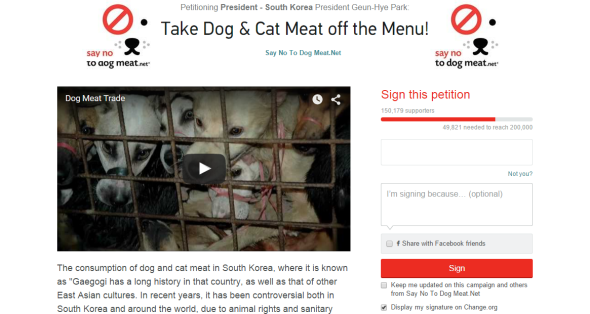
Image: Click the image above and help Say No To Dog Meat.Net end this torturous trade.
Statistics:
As explained in many past and present articles there remains no “factual” governmental statistics that can prove how many dogs and cats are killed “year round” within south Korea and, no real data to prove how many dogs and cats have been killed during the Bok Nal festival past and present. Without these statistics organisations such as Say No To Dog Meat must then rely on visual reports from the ground, interviews with traders and restaurant owners.
It would be deemed as grossly unprofessional for any organisation or individual to place any number into the domain without proof then ask for public donations. Instead bringing the trade and abuse into the limelight is considered more of a realist approach in the hope it will eventually bring the government to its feet to ban the trade or implement tough legislation to prosecute traders whom violate the laws already set out. Below are (estimates) and must not be taken as a proven or accurate statement.
The following data below derives from actual traders on the ground that have been interviewed during and after the Bok Nal festival. Included beneath is the average price of dogs and price for slaughter.
Estimated statistics on consumption and ownership:
- Trader 1 - Dog and cat meat restaurants number around 500-600 in Seoul alone.
- Trader 2 - During the last summer festival “estimates” of some 5 to 6 million dog meat dishes were sold during the twenty-one day event.
- Trader 3 - According to the Korean Kennel Foundation it’s believed that some 3.5 to 5.0 million dogs are kept as companion pets nationwide.
Estimated south Korean dog price and slaughter info:
- Gyeongdong Market in central Seoul - trader 1 states that the average price of slaughter/preparation/cooking and bagging is around 150,000 won.
- The current starting price for one dog comes in at 120,000 won and can exceed 190,000 won to 200,000 won stated trader 2.
- Separate pieces of dog meat are usually sold by weight, 5,000 won per geun (1.3 pounds/0.6 kilograms) explained trader 3.
- Another commonly served dish is sliced dog meat. A whole dog usually costs around 300,000 won in restaurants trader 4 stated.
- Gyeongseong Oriental Medicine Clinic, located near the market ask 350,000 won for a month’s worth of gaesoju; they charge half that if the customer provides the dog. Customers have to pay 20,000 won extra for slaughtering.
~ Source JoongAng Daily.
Image: Gyeongdong Market in central Seoul.
Changing Times:
While the trade in dog and cat meat continues times are in fact changing despite some organisations stating the trade is out of control to the point it cannot be controlled. Say No To Dog Meat, In Defense of Animals, Humane Society, Soi Dog and countless other organisations are all working towards providing dog meat traders with a more sustainable and healthier trade. Say No To Dog Meat’s mission for example is not just about “banning the trade”. One must remember this is indeed a trade and taking away people’s livelihoods despite the fact the western world sees such trades as cruel - will only increase unemployment, poverty and crime.
The board of directors have since founded, already devised a strong and trusted plan supported by over fifty thousand people and counting. Your donation can make a difference by providing traders and farmers with land and equipment to create a more attractive, non-abusive and a prosperous future ahead instead of using any donation to purchase dogs or cats from traders which only increases the circle of abuse.
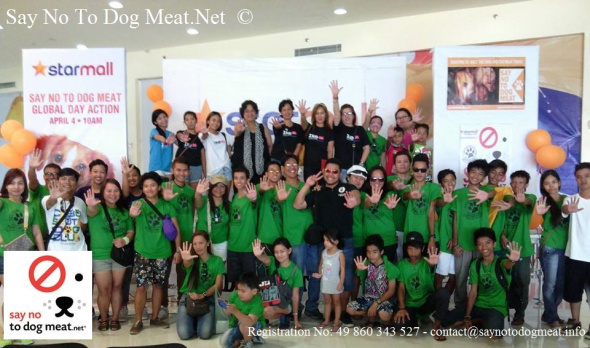
Image: Cebu, Philippines young activists aligned with the Say No To Dog Meat.Net organisation make their voice heard this past April 4th 2015 for S.N.T.D.M’s mass global anti pet meat trade demonstrations. The event hit Asia by storm supported by countless organisations and animal loving individuals. Say No To Dog Meat.Net rolled its youth education program out last year and has already seen a massive response from the young Asian community. Cebu children sent a message via Say No To Dog Meat to the pet meat-eating community - Please click the link above to view that message on Facebook. To join the Youth Club please contact: [email protected] today.
Creating fruit farms, vegetable farms, cotton farms, is one of many options already implemented by some organisations and the organisation Say No To Dog Meat. Establishment of pet rescue clinics has already been on the Say No To Dog Meat agenda of which removes dogs and cats from the streets, treating and, re-homing to trusted and caring families locally and internationally.
Many young people from all over Asia have already joined the Say No To Dog Meat mission and to date are lobbying with the organisation to bring this trade to an end while creating education and awareness to the many younger generations. Spreading the word among the young is pivotal and, has already proven to be a positive step for the Say No To Dog Meat organisation and mission objectives.
Say No To Dog Meat.Net:
Say No To Dog Meat.Net was established back in 2012 and founded in 2013. The organisation’s team are tackling traders within south Korea; Viet Nam; Cambodia; Thailand; Philippines; Nigeria; Ghana; Liberia and, Niger. Since founded Michele Brown, myself (Jose Depre), Donna Armes and our sister organisation have begun intensive lobbying of south Korean ministers, south Korean President, and the mayor of Seoul.
Say No To Dog Meat which is not related to the British charity (No To Dog Meat) also hosts petitions for each country they are actively working to end the trade within. South Korea being the most prominent of which the Aussie organisations petition holds over 150,159 signatures. The organisation requires at least a million signatures that will form part of the #Operationunite project bringing activists together to end this barbaric trade once and for all while offering dog and meat traders a way out of their traditional trade and, into a trade that is more profitable and all-round healthy.
Image: Stray dog looks on in sadness as friends are killed in front if him.
You can help Say No To Dog Meat.Net below:
- Sign the petition calling on the South Korean Government to take dog and cat meat of the menu.
- Get involved this September that will see many individuals lobbying for change this Embassy Day. South Korean embassy will be one of many embassies that the organisation will be pursuing for change.
- Encourage the younger generation to become involved. Say No To Dog Meat are currently seeking all young animal lovers to draw or paint their thoughts and, send in a small written message addressed to the South Korean government with an image of their hand with the words “I Say No To Dog Meat” on. (Watch the page for new updates)
- Host an awareness and education day this July in your city or begin planning for an adult/youth awareness and education day for Say No To Dog Meat’s #OperationUnite 2016 events.
- Donate. Say No To Dog Meat.Net cannot tackle the dog meat traders or farmers without your donation. (Please note: Say No To Dog Meat.Net “does not accept donations via cell phone devices”. All donations can be made via direct online transactions “safe and secure” or you can donate to the Say No To Dog Meat’s Environmental Companies F.A.A.W.S bank account on Pay Pal. Simply input this address - [email protected] and add the amount. You’ll receive like the SNTDM organisation will an electronic receipt, and you’ll be entered into the organisations free news letter subscription service.
For further information please contact the organisation hereto: [email protected]
Thank you for reading.
Dr Jose C. Depre
Chief Environmental Officer and CEO.

